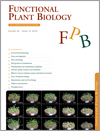
Functional Plant Biology
Volume 46 Number 10 2019
FP19068RNAi mediated silencing of dehydrin gene WZY2 confers osmotic stress intolerance in transgenic wheat
Drought stress negatively influences plant growth, survival and productivity. Here, we found that RNAi silencing of the WYZ2 gene could decrease the drought tolerance of transgenic wheat while overexpression of WZY2 in transgenic Arabidopsis significantly increased its tolerance to drought stress. Our work suggests that WZY2 may act on the stress-resistance of a plant through influencing synergistic/antagonistic cross-talk among various stress signalling pathways.
FP18316Overexpression of Triticum durum TdAnn12 gene confers stress tolerance through scavenging reactive oxygen species in transgenic tobacco
Abiotic stresses negatively affect the growth and productivity of crop plants around the world. We report here the functional characterisation of TdAnn12 in transgenic tobacco and its involvement in salt and drought stress tolerance through the removal of reactive oxygen species. These results show that TdAnn12 could be a useful candidate gene for engineering abiotic stress tolerance in cultivated plants.
In this work we investigated the responses of Medicago sativa seedlings to different levels of UV-B light. Seedlings grew better under lower levels of UV-B light (UV-B irradiation dosage <17.35 μW cm–2 day–1) and have higher UV-resistance. However, higher levels of UV-B light (UV-B irradiation dosage >17.35μW cm–2 day–1) caused severe stress injuries to seedlings, and seriously inhibited growth and development. Further tests have suggested that the significant induction of plant antioxidant capacity and flavonoid excessive accumulation play a central role in alfalfa UV-B tolerance to the lower levels of UV-B irradiation.
FP19103The contrasting leaf functional traits between a karst forest and a nearby non-karst forest in south-west China
 , Shi-Dan Zhu, Jiao-Lin Zhang, Patrick M. Finnegan, Yan-Juan Jiang, Hua Lin, Ze-Xin Fan and Kun-Fang Cao
, Shi-Dan Zhu, Jiao-Lin Zhang, Patrick M. Finnegan, Yan-Juan Jiang, Hua Lin, Ze-Xin Fan and Kun-Fang Cao
Karst habitats cover extensive areas of south-west China; however, we know little about the adaptive mechanisms of plants there. We compared leaf functional traits between a karst forest and a nearby non-karst forest and found that karst trees had more conservative water use and higher leaf P concentrations. Our results show that trees in the karst forest are structurally and physiologically acclimated to the dry, nutrient-rich soil.
FP19079Light regulates hydrogen sulfide signalling during skoto- and photo-morphogenesis in foxtail millet
After more than a decade, the role of H2S has changed from a hazardous substance into a beneficial gasotransmitter. In the present study we show that light, an indispensable factor for plant growth, provokes H2S generation by regulating H2S-producing enzyme coding genes and enzymatic activity. This research provides meaningful connection for environmental signal light and endogenous signal H2S, both of which are important in regulating various plant physiology processes.
FP18259Induction of the heat shock response in Arabidopsis by heat shock protein 70 inhibitor VER-155008
It has not yet been determined how plants sense extremely high temperature in the growth environment. Here we propose that a common chaperone HSP70 can be a heat sensor of plants. The inhibition of HSP70 by a specific inhibitor VER-155008 efficiently induced the heat shock response and enhanced the heat tolerance of Arabidopsis.
FP18303Physiological response of Posidonia oceanica to heavy metal pollution along the Tyrrhenian coast
Bioindicators of marine pollution enable fast and reliable monitoring of environmental conditions over time. In this work, we analysed timely warning symptoms of pollution in the marine phanerogam Posidonia oceanica, correlating the physiological response of plants from different meadows to the content of leaf heavy metals. Our results suggest that prolonged exposures to high heavy metal concentrations may interfere with the plants’ defence mechanisms.
FP18262The effect of vanadium(IV) complexes on development of Arabidopsis thaliana subjected to H2O2-induced stress
 , Małgorzata Kozieradzka-Kiszkurno, Małgorzata Kapusta, Anna Aksmann, Dagmara Jacewicz, Joanna Drżeżdzon, Aleksandra Tesmar, Krzysztof Żamojć, Dariusz Wyrzykowski and Lech Chmurzyński
, Małgorzata Kozieradzka-Kiszkurno, Małgorzata Kapusta, Anna Aksmann, Dagmara Jacewicz, Joanna Drżeżdzon, Aleksandra Tesmar, Krzysztof Żamojć, Dariusz Wyrzykowski and Lech Chmurzyński
This report demonstrates the influence of oxidovanadium(IV) complexes on Arabidopsis thaliana. In the presence of vanadium(IV) complexes, plants proceeded through their entire life cycle, with proper morphological and cytological organisation of leaf and root tissues. H2O2 treatment caused damage and death to plants. Plants pretreated with 10−6 M vanadium(IV) complexes survived longer in the presence of H2O2, suggesting some role of conjugated vanadium(IV) in response to stress factors.



